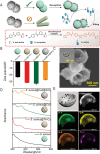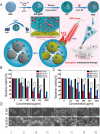New Strategies for the Treatment of Diabetic Foot Ulcers Using Nanoenzymes: Frontline Advances in Anti-Infection, Immune Regulation, and Microenvironment Improvement
- PMID: 40635719
- PMCID: PMC12240001
- DOI: 10.2147/IJN.S531396
New Strategies for the Treatment of Diabetic Foot Ulcers Using Nanoenzymes: Frontline Advances in Anti-Infection, Immune Regulation, and Microenvironment Improvement
Abstract
Diabetic foot ulcers are one of the most serious consequences of diabetes, arising from vascular impairment of the skin and disturbances in the microenvironment. This condition involves pathological changes such as wound infection, hyperglycemia, hypoxia, oxidative stress, and cellular dysfunction, necessitating multifaceted interventions. Traditional treatments often target only the wound itself, resulting in limited effectiveness. In contrast, nanoenzymes offer a promising therapeutic option due to their excellent biocompatibility and tissue permeability. They exhibit higher catalytic efficiency, optimal size and structure, and improved stability compared to natural enzymes. Encapsulating various nanoenzymes within novel biomaterials can enhance therapeutic outcomes through antibacterial action, glycemic control, oxygen delivery, antioxidative effects, anti-inflammatory properties, and angiogenesis promotion. This approach represents a key direction for future diabetic wound treatment. This article summarizes the role of nanoenzymes in diabetic wound management and discusses the potential mechanisms of their action. We also provide an outlook on their application prospects, aiming to advance their clinical utilization.
Keywords: angiogenesis; antibacterial action; chronic wound; hyperglycemia; oxidative stress.
© 2025 Jia et al.
Conflict of interest statement
The authors report no conflicts of interest in this work.
Figures









Similar articles
-
Topical antimicrobial agents for treating foot ulcers in people with diabetes.Cochrane Database Syst Rev. 2017 Jun 14;6(6):CD011038. doi: 10.1002/14651858.CD011038.pub2. Cochrane Database Syst Rev. 2017. PMID: 28613416 Free PMC article.
-
Nanozymes for Accelerating the Foot Wound Healing: A Review.Int J Nanomedicine. 2025 Jul 10;20:8907-8934. doi: 10.2147/IJN.S517671. eCollection 2025. Int J Nanomedicine. 2025. PMID: 40661658 Free PMC article. Review.
-
Psychological interventions for treating foot ulcers, and preventing their recurrence, in people with diabetes.Cochrane Database Syst Rev. 2021 Feb 8;2(2):CD012835. doi: 10.1002/14651858.CD012835.pub2. Cochrane Database Syst Rev. 2021. PMID: 35653236 Free PMC article.
-
Phytofabricated Farsetia aegyptia-derived silver nanoparticles mediate antibacterial and wound-healing activities in diabetic foot infection rat model.Inflammopharmacology. 2025 Jun;33(6):3233-3254. doi: 10.1007/s10787-025-01789-9. Epub 2025 Jun 3. Inflammopharmacology. 2025. PMID: 40461756
-
From Wound Dressing to Tissue Regeneration: Bilayer Medicated Patches for Personalized Treatments of Chronic Wounds.ACS Appl Mater Interfaces. 2025 Jun 18;17(24):35240-35261. doi: 10.1021/acsami.5c06444. Epub 2025 Jun 5. ACS Appl Mater Interfaces. 2025. PMID: 40469021 Free PMC article.
References
-
- Saeedi P, Petersohn I, Salpea P, et al. Global and regional diabetes prevalence estimates for 2019 and projections for 2030 and 2045: results from the International Diabetes Federation Diabetes Atlas, 9(th) edition. Diabet Res Clin Pract. 2019;157:107843. doi: 10.1016/j.diabres.2019.107843 - DOI - PubMed
Publication types
MeSH terms
Substances
LinkOut - more resources
Full Text Sources
Medical

